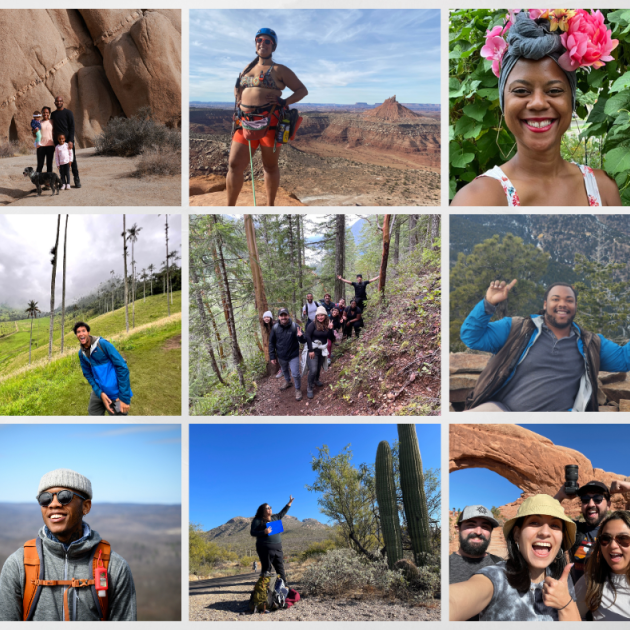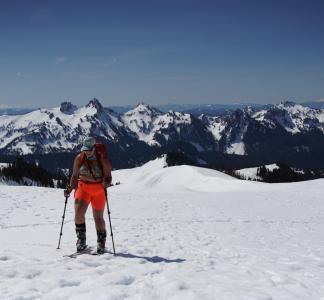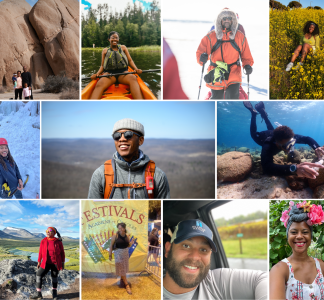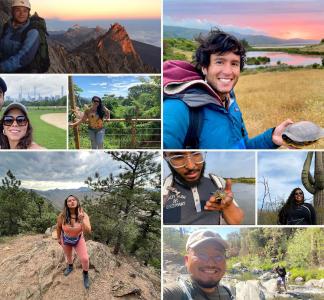7 disability advocates talk about accessibility and ableism outdoors
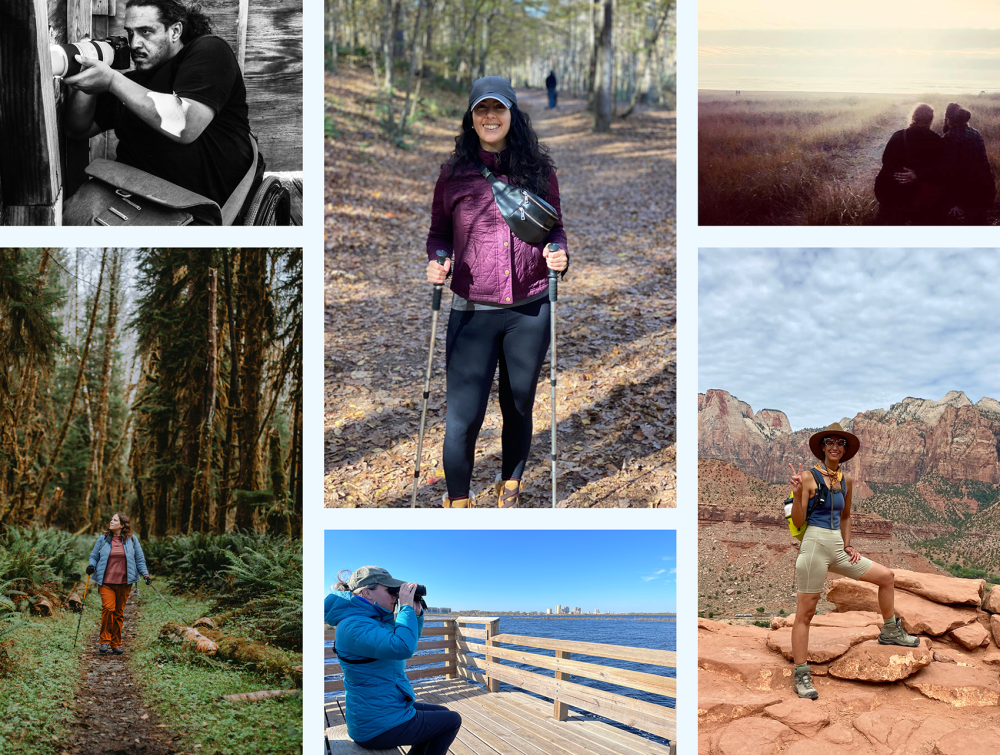
Image collage caption: Upper left: Joseph Saunders at LLELA Nature Preserve near Dallas, TX, photo: Holla Bing; upper middle: Catarina Rivera hiking near Atlanta, GA; upper right: Anni and John Furniss sitting in Long Beach, WA; lower left: Syren Nagakyrie hiking with their service dog through a redwoods forest, photo: Eddie Bauer/Elise Giordano; lower middle: Freya McGregor birding from a bench at Gulf State Park, AL, photo: Patrick Oaks; and lower right: Tatsuko Go Hollo standing on red boulders in Zion National Park.
For many, experiencing the outdoors has more to do with accessibility and ableism, rather than “ability”
When we talk about outdoor adventures, we usually envision breathtaking landscapes, thrilling hikes, or serene lakes. But for people with disabilities, accessing and enjoying the wonders of nature can be a real struggle.
In the United States alone, more than one in four adults have some form of disability, with Black and Indigenous people having higher rates of disability. Disabilities can range from mobility differences to neurodivergence. It's important to recognize that people with disabilities are a diverse group with a wide range of needs, and ensuring access to the outdoors and welcoming spaces remains an ongoing challenge for many.
Unfortunately, outdoor environments often fall short in terms of accessibility.
Some of the obstacles facing people with disabilities: uneven terrain, steep inclines, a lack of ramps and handrails, narrow pathways that aren't wheelchair-friendly, absence of closed captioning on video exhibits and maps without tactile or audio features. While federal agencies are making efforts to address some of these issues, there is much work to be done in improving access to all types of parks and public lands.
Aside from physical obstacles, ableism also plays a significant role in making many feel unwelcome in outdoor spaces. These experiences arise from society's narrow definition of capability and the absence of inclusive practices in outdoor recreation. People with disabilities are also often left out of conversations regarding climate and environmental justice, resulting in inaccessible systems and policies. In recent years, online communities and organizations like Disabled Hikers, Unlikely Hikers, Wildability and Disabled & Outdoors have emerged to challenge this status quo.
We spoke with seven people involved in this advocacy work about their connections to the outdoors, how they find joy in nature and their fight for a more inclusive outdoors and better access to parks and public lands.
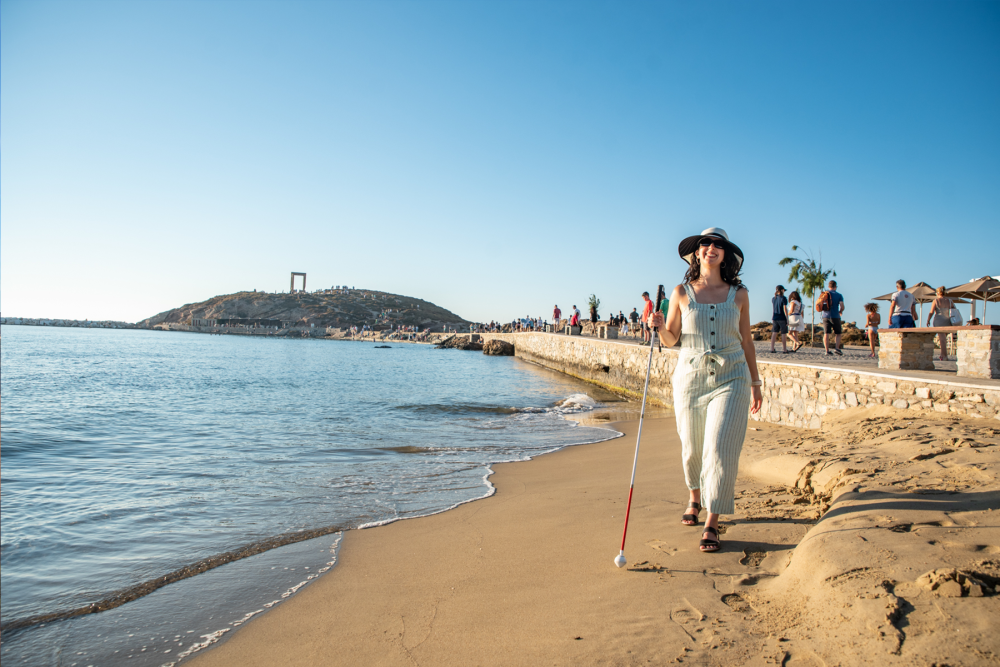
Catarina walking on the beach in Naxos, Greece.
Catarina Rivera
Catarina (she/her) is a public speaker, DEIA consultant and content creator who uses her platforms to smash disability stigmas and promote awareness, inclusion and accessibility. For Catarina, who is blind and deaf, the outdoors has always been a space of freedom and sensory experiences. Whether she is feeling the warmth of the sun or enjoying the scents and textures of nature, it offers a much-needed break from technology and an opportunity to reconnect with herself. She also cherishes outdoor moments of public celebration and community, whether that’s salsa dancing or exploring food markets.
However, Catarina acknowledges the challenges and barriers faced by people with disabilities in outdoor activities—from uneven terrain in hiking areas, to inaccessible trail markers, to beaches that can’t be reached by wheelchair.
Catarina has also experienced ableist and unaccommodating attitudes, including from a guide who wouldn’t provide a safe place to keep her hearing aids from getting wet.
“I've noticed a lack of education with activity providers on how to work with disabled people, how to communicate. […] Disabled people are really resourceful, but some people don't even want to try working with us.”
These kinds of obstacles can be addressed in part by involving the disability community in all aspects of planning and managing outdoor spaces. There’s also a need for policymakers and funders to take action and allocate budgets specifically for improving accessibility in new and renovated projects.
It's important to go beyond accommodating people with disabilities, says Catarina, to creating truly inclusive environments that benefit everyone's mental and physical well-being. By working together, involving the disability community and committing to disability justice principles, Catarina believes we can transform outdoor spaces into inclusive havens that allow everyone to fully enjoy the wonders of nature.
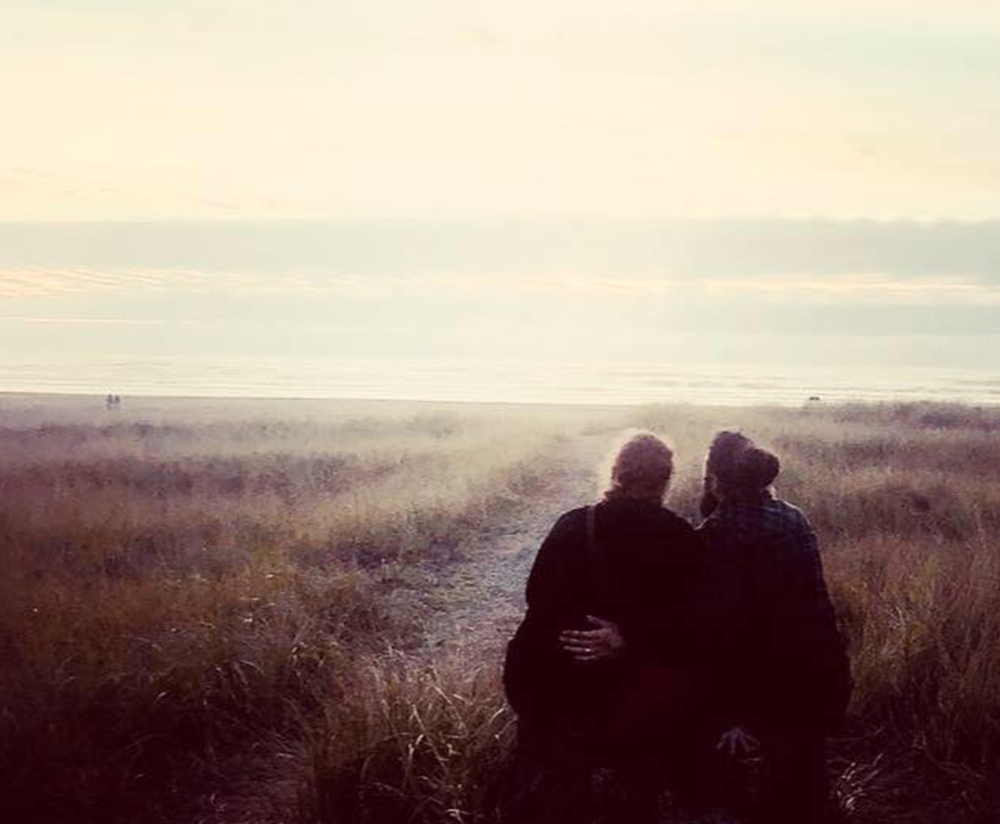
Anni and John sitting during sunset in Long Beach, WA
John and Anni Furniss, Washington
Anni (she/her) and John (he/him) Furniss have been together 11 years and married for almost eight of them. John is a woodworker who shares his incredible work on social media and on his blog, and Anni is a mixed media artist. John is blind and has epilepsy and chronic pain as a result of a traumatic brain injury. Anni has a genetic condition called hypermobility that affects connective tissue, degenerative bone disease and anxiety and sensory issues. They both share a deep connection with nature.
The Furniss’ nature adventures began with a trip to the ocean—and some trepidation from John, a Midwesterner who had never visited before. But once he was able to absorb the beauty of the water through his non-sight senses—mostly hearing and touch—it unlocked a new world of experience in the outdoors.
“[John] said it wasn’t what he expected. He was pleasantly surprised at the pull of the waves on his ankles and how his toes sunk into the wet sand with each receding current. He felt the vastness of the water that went on and on. The sound of the tide, the wind and the gulls were a great soundtrack.” - Anni
Since then, John and Anni have enjoyed numerous nature outings, developing a special appreciation for places like a local trout hatchery and park called Columbia Springs that offers accessible trails, tactile art and a peaceful environment away from traffic noise.
They’ve faced obstacles in nature, too: unkempt trails full of tripping hazards, steep slopes without hand railings, visitor information lacking Braille or audio descriptions. More accessible facilities are vital to creating more inclusive environments for the disability community.
There is also work to be done on the culture front. John and Anni point out that park visitors should be more considerate of people with disabilities. That includes moving aside or approaching slowly, understanding that not everyone is the same.
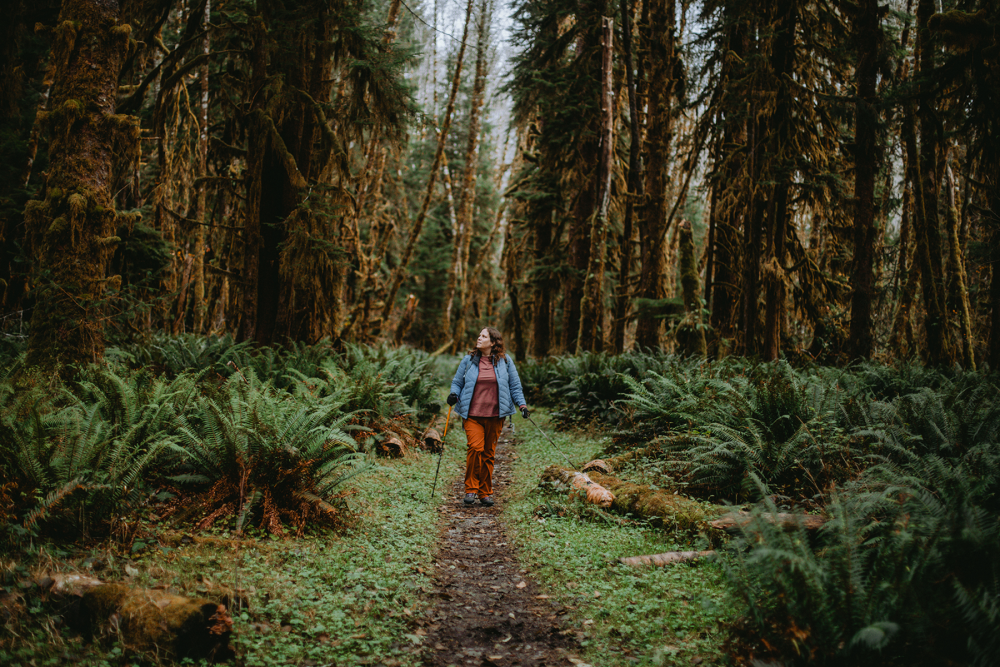
Syren hiking with their service dog through a redwoods forest.
Eddie Bauer/Elise Giordano
Syren Nagakyrie, Washington
Syren’s (they/them) connection to the outdoors started in childhood—from hanging out in their yard, listening to birds and feeling a sense of belonging in nature. As a child, Syren was constantly sick, and because of a combination of factors— their family didn’t have much money, and there was little social awareness about disabilities – it wasn’t possible to go out and do typical outdoors activities like sports or camping. Syren is neurodivergent and has hypermobile Ehlers-Danlos Syndrome (a connective tissue disorder that affects many organs and ligaments and causes frequent joint dislocations and chronic pain) and Postural Orthostatic Tachycardia Syndrome (an autonomic nervous system condition that also affects blood pressure and circulation).
Later, Syren got into hiking. But as they explored supposedly “accessible” trails around Washington, they often encountered obstacles that hadn’t been mentioned on blogs and park websites. This led to the creation of their blog, "Disabled Hikers," which offers detailed trail guidance with more context and nuance, raises awareness about issues faced by hikers with disabilities and serves as a platform for organizing group hikes. Disabled Hikers became a nonprofit in 2021 and is a growing national organization, with dozens joining their hikes and online conversations.
Syren emphasizes that the guidelines for making sure places are accessible are not always sufficient. We must work with disabled folks to understand what’s really needed. There is a lot of wisdom and experience in the disabled community that can inform the creation of truly inclusive outdoor spaces.
“There’s an unspoken perception that all hikers are abled bodied – but disabled people hike too and there are many ways we do it. We are challenging ableism that exists everywhere. And while it does start with providing good trail info and increasing the number of accessible trails – we also have to address the culture.”
For Syren, it comes down to this: Nature is fundamental to our well-being as humans, and everyone deserves access to it—not just a privileged few. Cutting people off from nature means cutting them off from a significant aspect of their identity.
Disabled people, according to Syren, adapt to challenges in a similar way ecosystems adapt to disturbances and disasters. Once people learn to recognize this thread everywhere, they'll see that disability is anything but "unnatural," and gain a more holistic understanding of what it means to have a life-supportive environment.
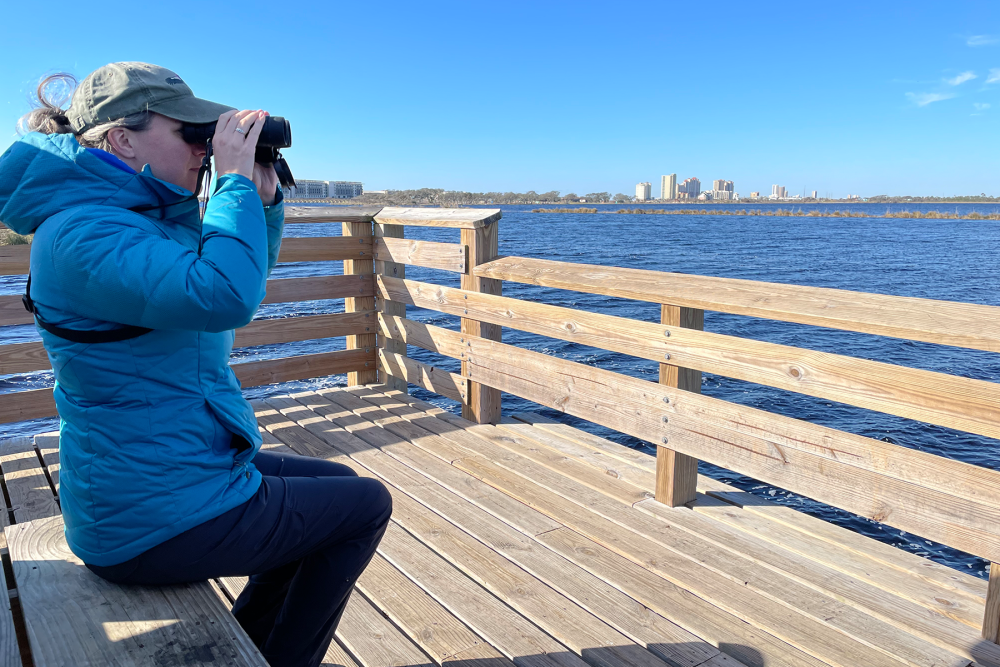
Freya McGregor birding from a bench at Gulf State Park, AL.
Patrick Oaks
Freya McGregor, currently in Alabama
Freya (she/her) is originally from Australia but now living in Alabama because she’s a military spouse. Through her business, Access Birding, she provides consulting and training services to nature organizations to help them improve access and inclusion for disabled birders and nature lovers. She is also writing a book about accessible birding in the U.S. for Princeton University Press, and is a research associate at Virginia Tech. Freya has a knee disability that made her shift to stationary birding, but she finds it just as enjoyable as the “traditional” practice—and an indication of how the pastime can be adapted according to each birder’s ability or comfort level.
For Freya, birding is a family affair. Her husband, who lives with PTSD, finds solace and relaxation on these outings in nature. It’s also a cross-continent bonding opportunity, as they share notes with her family overseas on birds from both North America and Australia.
But as with other outdoor recreation activities, Freya believes there is a cultural stigma around disability and many barriers to access. These barriers include physical barriers, lack of information, social assumptions and institutional shortcomings.
“There are physical, social, cultural and institutional barriers. Things like knowing detailed information about trail conditions ahead of time is important but for land managers, it's not been a priority to get that information assessed, documented and put on websites and interpretive materials and maps.”
Freya emphasizes that recreation in outdoor spaces—and the health benefits and other positive effects that come with it--should be available to everyone. When these activities are made more accessible, it often ends up helping more than just people with disabilities. For example, she says that widening trails and more clearly delineating them tends to make most hikers stick to the path and avoid disturbing local plants.
To really promote inclusivity in birding and the outdoors, Freya says organizations and agencies should start by seeking expert advice from people with lived experiences (while compensating them fairly for their time); listening to the community's needs; assuming competence in all individuals and treating everyone with kindness and respect; and recognizing that societal barriers, not individual disabilities, create barriers to participation.
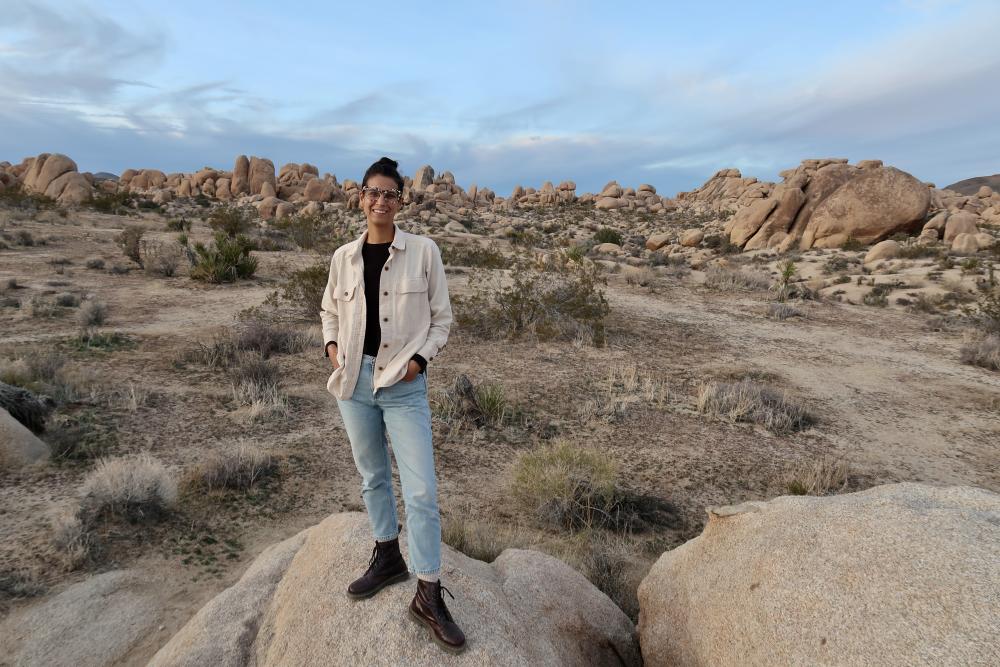
Tatsuko stands atop a boulder in Joshua Tree National Park, CA.
Tatsuko Go Hollo, California
Tatsuko (they/them) has spent the past year traveling the country with their child to hike, camp and learn about the lands they visit. Tatsuko has worked as a policy expert and family advocate in nonprofit and government sectors for two decades, but their personal connection to the outdoors began in their childhood backyard, where they spent time observing and appreciating nature. This relationship deepened in adulthood, after Tatsuko experienced a brain injury that left them immunocompromised and isolated.
Unable to engage in many physical activities, Tatsuko started taking pictures of the sky, marking milestones in their treatment and changes in their body. Over time, Tatsuko began spending more time outdoors, starting with walks around the block and eventually progressing to hikes.
“Nature became the most pivotal player in my understanding of my disability. And today, though I love hiking, my connection to the outdoors isn't about epic peaks or adding mileage. It's the time I spend observing the sky that will always be my most meaningful moments in nature.”
When discussing systemic challenges faced in outdoor spaces, Tatsuko highlights two main issues. First, a lack of signage or trail maintenance that often leads to getting lost or losing your balance while out hiking. Tatsuko emphasizes that addressing this will provide benefits beyond the disability community--from people with baby strollers to elderly folks. This, in turn, builds community.
Second, the enforcement of rigid "trail rules" or “Leave No Trace” expectations can sometimes lead to ableism. Tatsuko says despite trying their best, they sometimes get confused and can’t fully process a situation. They might make mistakes like not stepping aside for uphill hikers or stepping too far off trail. Tatsuko encourages considering the unique challenges faced by people with disabilities and adopting a more nuanced approach to applying these rules.
In all decision-making about public lands and outdoor recreation, Tatsuko stresses the importance of consulting and hiring people with disabilities. Involving them at all levels of planning and implementation will lead to better-designed accessible spaces that help avoid stressful or dangerous experiences.
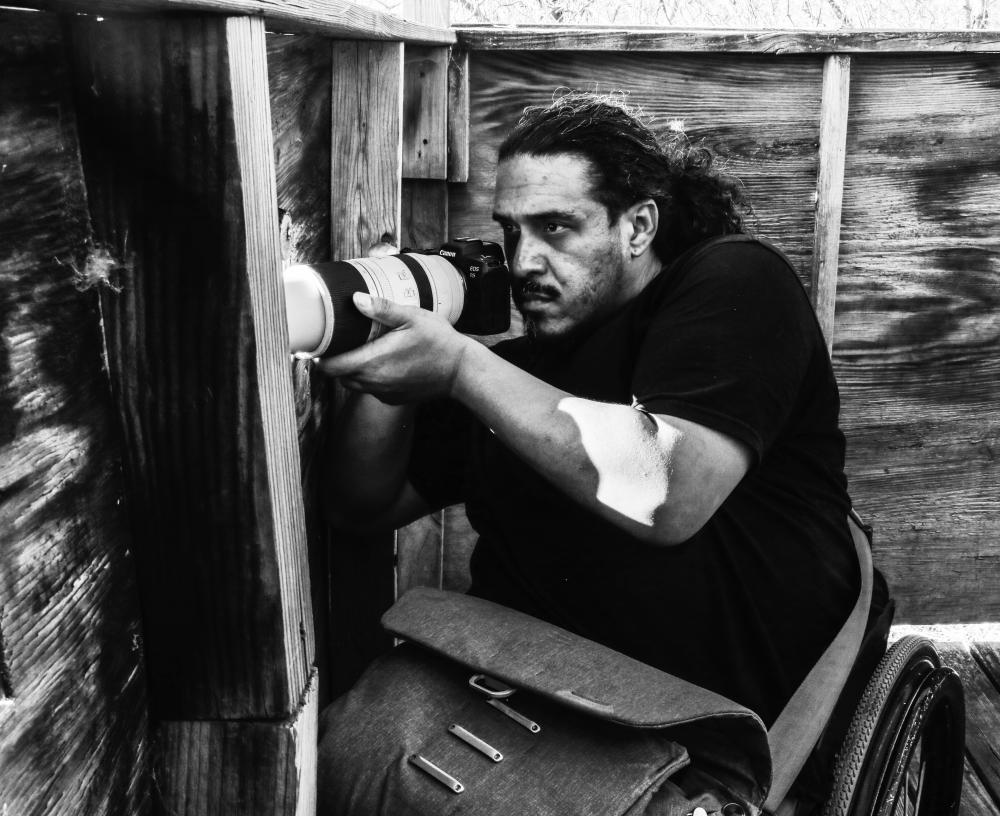
Joseph at LLELA Nature Preserve near Dallas, TX.
Holla Bing
Joseph Saunders, Oklahoma
Joseph (he/him) is a professional wildlife photographer with a specialty in macro photography (extremely close-up photos of insects and other subjects). He is also a member of BlackAFinStem and an advocate for equity in the environmental movement and outdoor spaces. Nature, he says, is a constant source of peace and inspiration that never fails to arouse his curiosity. This connection dates back to his childhood fascination with reptiles.
Joseph uses a wheelchair, and his experiences have highlighted some of the ongoing challenges faced by people with disabilities. For example, some popular lakes lack access ramps or sidewalks. He's talked with engineers in an attempt to develop a wheelchair that is better adapted to navigating more difficult terrain outdoors, thus gaining a more immersive experience, but so far there hasn’t been a solution. He hopes there will be some improvements in that area down the road.
These kinds of gaps feed the common perception that outdoor spaces are primarily for the able-bodied. Many people might not know they enjoy the outdoors because they've never had the chance to experience it.
"City parks are often turned into shops when we could actually be turning them into usable green spaces that are not only for the experiences of the people that live there, but they could also create better habitats for the animals that could be passing through – like migratory birds.”
Joseph also recognizes that ensuring accessibility is not necessarily a simple issue on certain protected lands, like wilderness areas. There needs to be a balance between human use and environmental preservation. As a wildlife lover, Joseph would never want to harm any sort of sensitive species or a sensitive habitat.
But there’s still plenty to be done to make outdoor spaces more inviting and open to the diverse spectrum of people who want to be in nature. He emphasizes more resources for things like planting trees and native gardens. This not only benefits people with disabilities but enhances the overall environmental and social fabric of communities.
Something Joseph is unapologetically assertive about is advocating for diverse voices in decision-making processes, especially in organizations and policies that impact the outdoors. He, and many others in this blog, believe people with disabilities should be part of the processes when it comes to accessibility.
